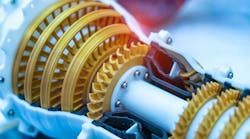By Courtney E. Howard
PARSIPPANY, N.J.—DRS Technologies Inc. in Parsippany, N.J., has completed full-power testing, as required by the U.S. Navy, of its power-dense permanent magnet motor (PMM) and drive at the U.S. Navy’s integrated power system (IPS) land-based test site (LBTS) in Philadelphia.
Navy officials contracted DRS to develop the motor and drive as part of the DDG 1000 Zumwalt-class multi-mission surface warship program.
The DRS Technologies permanent magnet motor provides 36.5 megawatts (roughly 50,000 horsepower) and more than two million foot-pounds of torque in a dual-ring design. During testing, the motor ran at full power on one ring at 18.25 megawatts, the maximum load available at the land-based test site, explains a representative.
The test validated not only the thermal and electrical operation of the motor and drive, but also the company’s permanent magnet motor technology as a viable alternative for naval ship propulsion.
Permanent magnet motor technology offers the Navy benefits over conventional ship propulsion systems—including high power density at a lower weight and volume than traditional motors; increased operating efficiency for fuel savings; increased power; and improved performance.
DRS engineers have enhanced the design of the motor based on lessons learned from the EDM testing. As a result, the evolutionary motor design will deliver lower weight, decreased volume, and greater performance.
“The validation of permanent magnet motor technology is a significant milestone for the Navy and DRS,” says Roger N. Sexauer, II, president of the DRS Technologies Power Systems business. “The completion of this test and our improved PMM design provide the Navy with the confidence that the substantial weight, volume, cost, and performance advantages of PMM technology can be realized in future ship designs.”
The company’s permanent magnet motor technology is applicable for all military electric drive propulsion systems and platforms, including the DDG 1000, CG(X) next-generation cruisers, submarines, mobile landing platforms, and commercial marine applications, company officials say.
An electric generation plant can supply sufficient power for all the ship’s electrical requirements, including advanced weapons launch, combat and sonar systems, maneuver and propulsion, and other power needs.


